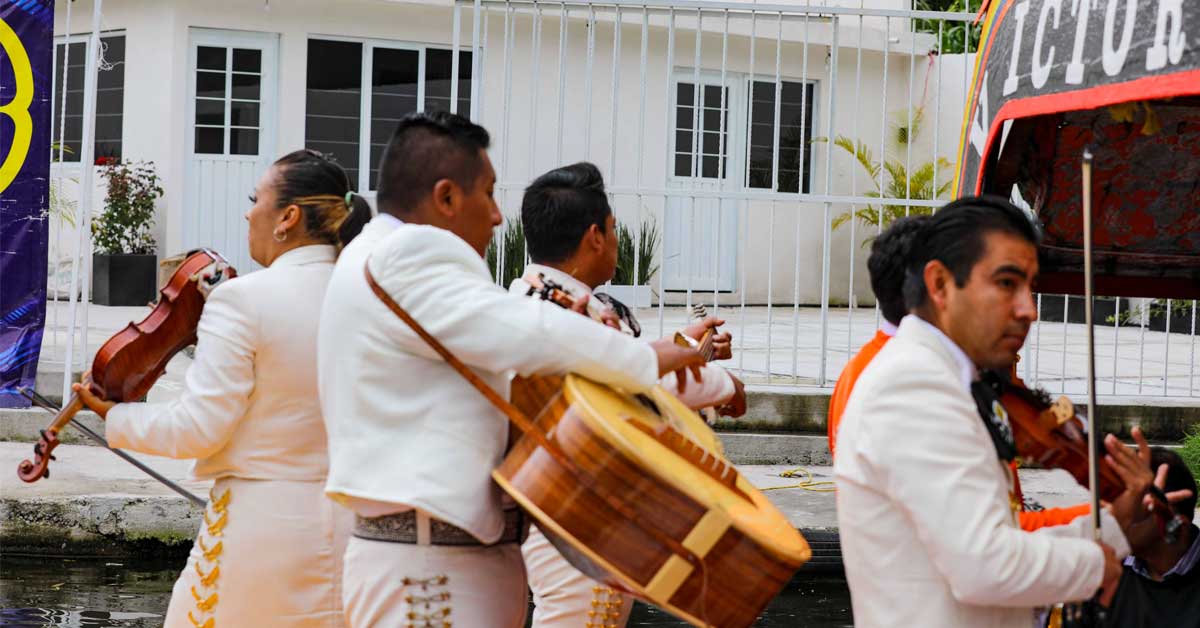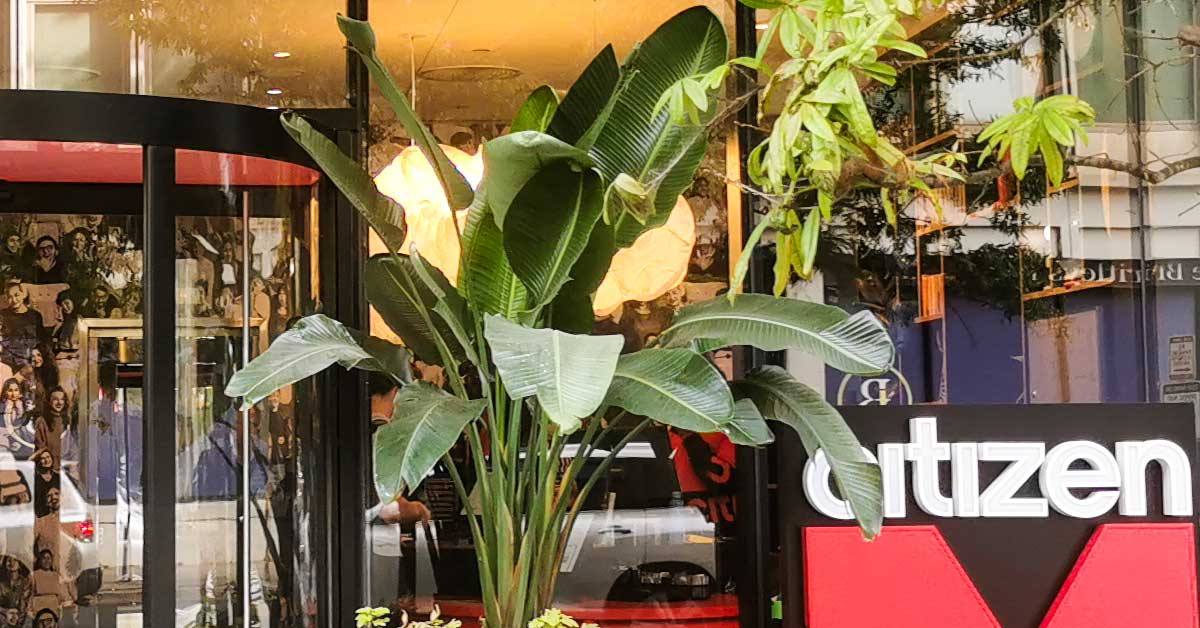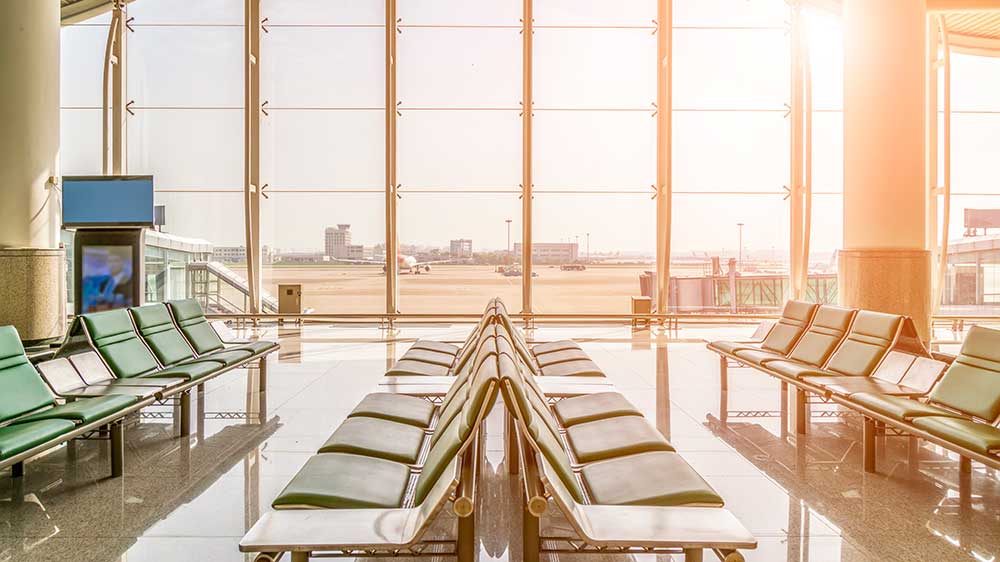Plaza Garibaldi: Where Mexico City Dances to the Mariachi Beat
Plaza Garibaldi, Mexico City’s famous hub for live mariachi music, is a must-see square in the Centro Histórico. There, every tourist can feel the very soul of Mexico. Mariachis dressed up in silver-studded charro suits and large sombreros passionately sing their hearts out right in the plaza and inside surrounding historic cantinas. All around, memorabilia honours unforgettable legends of their music.
In the heart of Mexico City, not far from well-known landmarks like Palacio de Bellas Artes and the Zócalo, lies a charming little square known as Plaza Garibaldi. This “magical neighborhood” spot is where mariachi bands from all over the country gather to find gigs and perform under the open sky or in nearby restaurants.
The square is lined with old, colorful colonial townhouses, beautifully decorated with wrought-iron balconies. Nowadays, most of them host a mix of bars, restaurants, nightclubs, pulquerías, food courts, along with a museum, and even a mariachi school.
Locals and foreigners alike come to Plaza Garibladi to dance, sing along the mariachi and eat in these old-charm venues. It’s a heart-warming place, quite energetic, and safer than you might think.
Disclosure: This article contains affiliate links. If you make a purchase after clicking one of these links, I earn a small commission from that website at no extra cost to you. Learn more: Disclosure policy.
 Short Mariachi History
Short Mariachi History
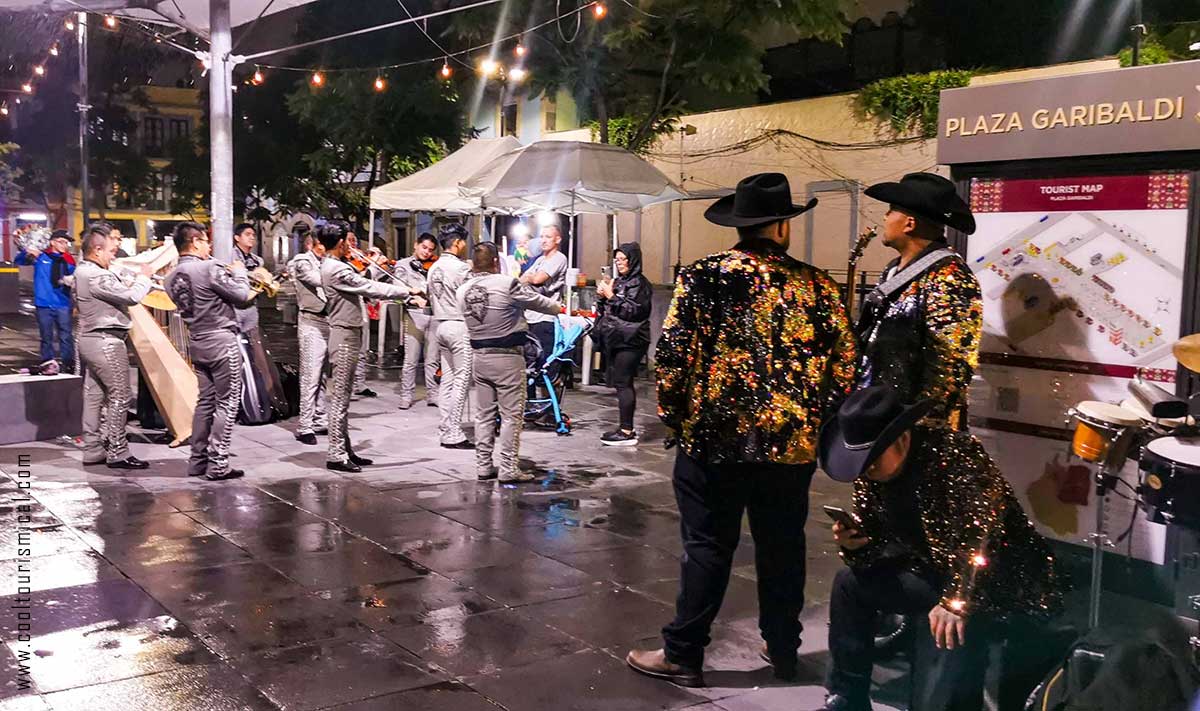
Listening to Mariachi in Plaza Garibaldi, Copyright © Cooltourismical.com
I feel I should start by defining mariachis, even though many of you might be already familiar with the term. Mariachis are Mexico’s traditional musical ensembles (folklore groups), mostly known for their deeply emotional songs. The true storytellers keeping Mexico’s history and traditions alive, in movies and real life.
Some say mariachi music began in the 18th century in Jalisco, particularly in Cocula and Tecalitlán, as a rural folk tradition played with violins, vihuelas, and guitarróns. Those early mariachis performed some melodies called sones and jarabes. But over time, when the trumpets were introduced and shaped mariachi music into the bold, unmistakable sound that it is today.
A mariachi group is made of four to twelve musicians, all dressed in charro suits—tight, embroidered jackets and trousers with silver studs, wide-brimmed sombreros, and polished boots. It’s both an attire and a statement inspired by 19th-century horsemen. Their current repertoire includes rancheras, corridos, sones, boleros, and patriotic anthems, each performed with a fiery passion.
 Plaza Garibaldi CDMX, a Mariachi Mecca: How It All Started
Plaza Garibaldi CDMX, a Mariachi Mecca: How It All Started

Colonial Buildings in Garibaldi, Mexico City, Copyright © Cooltourismical.com
Plaza Garibaldi is the undisputed mecca of mariachi music, a place where tradition and nightlife collide, the Mexico City stage where mariachi culture flourished for the last century. But how did the mariachi bands got all the way to Plaza Garibaldi in Mexico City from the Western parts of Mexico?
Originally known as Plazuela de Jardín, this square took on its current name in honor of Italian revolutionary Peppito Garibaldi, a fighter in the Mexican revolution, in the early 20th century. But the movement of mariachis into the plaza itself was largely influenced by President Álvaro Obregón in the 1920s
During Obregón’s presidency (1920-1924), mariachi groups were brought from Jalisco to Mexico City to perform at official events, solidifying their status as a national musical symbol. As more musicians arrived, they needed a central place to gather and find work. Plaza Garibaldi became that spot,
However, its significance extends far beyond politics.
The key figure in bringing mariachis to Plaza Garibaldi was Juan Hernández, the founder of Salón Tenampa, the legendary cantina that has been a mariachi hotspot since 1925.
Hernández, originally from Jalisco, opened Salón Tenampa as a place for fellow Jaliscienses in Mexico City to enjoy traditional food and music from their homeland. Wanting to recreate the atmosphere of his native state, he invited mariachi groups from Cocula and Tecalitlán—the very birthplace of mariachi music—to play at his cantina. This move helped establish Plaza Garibaldi as the go-to place for mariachi.
Soon, mariachis were no longer just playing inside Tenampa, but gathering outside, in the plaza, drawing more and more groups who would wait for customers looking to hire a band for serenades, celebrations, or even impromptu performances.
However, the Plaza Garibaldi movement did not stop at mariachis. Musicians from other parts of Mexico came bringing their own music and costumes.Today, alongside mariachis, you’ll also find Norteños from northern Mexico. Their music is heavily influenced by the German and Czech immigrants who introduced accordion and polka rhythms to the region. You may also hear the sounds of Son Jarocho, which reflects the multicultural heritage of Veracruz (a colonial port city): strong African, Caribbean, and Spanish influences, harps and tambourines, with harps and tambourines.
About 20 years ago, Plaza Garibaldi was showing signs of decline. But thanks to a major restoration and refurbishment program, the area has since been revitalized, bringing new life into it, – into the place where generations of musicians have kept the spirit of rancheras, sones, and corridos alive.
 Things to Do at Plaza Garibaldi
Things to Do at Plaza Garibaldi
Plaza Garibaldi is pure, unapologetic Mexico, – loud, alive, carrying a long tradition. It’s where the mariachi music never ends — trumpets, violins, and deep voices are floating in the air at all hours. More or less connected to mariachi, there are plenty of things to do in Plaza Garibaldi, from partying and being serenaded to eating at old cantinas, sipping on tequila like legends before you, and even visiting one of the coolest museums in town.
No plans needed — just show up. Below, a bit of everything you’ll find and want to try in Plaza Garibaldi, Mexico City: key attractions, tips on hiring mariachi, what and where to eat.
📌 Hiring A Mariachi
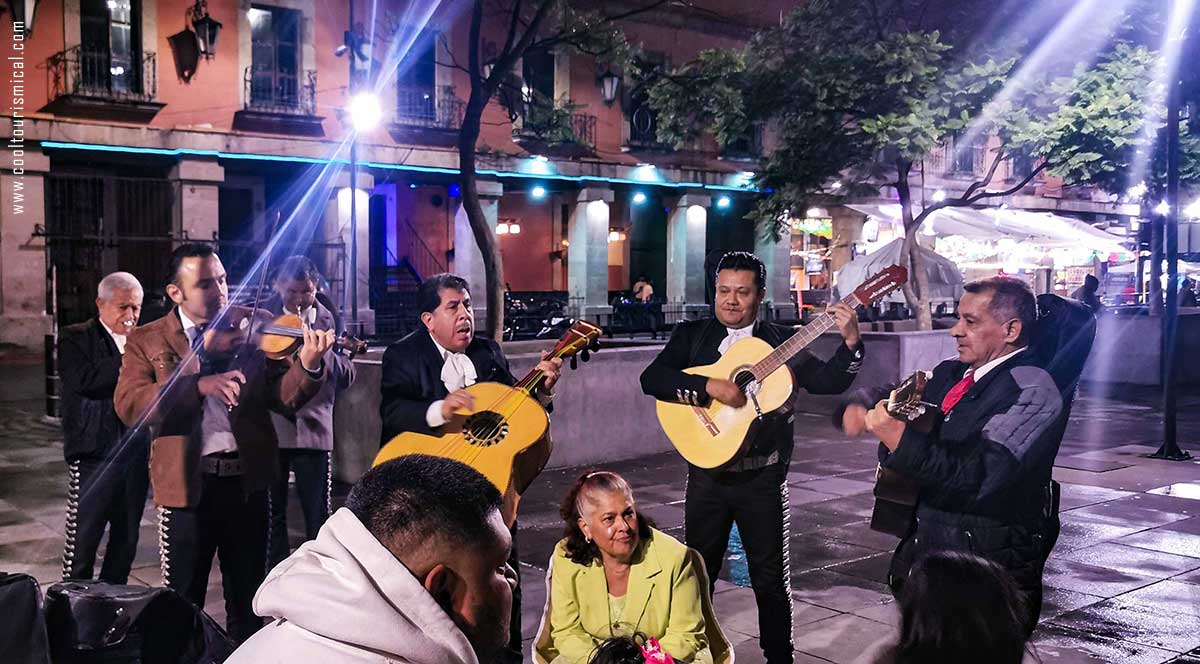
Hiring a Mariachi in Plaza Garibaldi Mexico City, Copyright © Cooltourismical.com
Finding a mariachi in Plaza Garibaldi is effortless. Because, most of the times, they find you.
Plaza Garibaldi is the place for spontaneous serenades by wandering bands. The moment you’ll enter the plaza, you’ll see all these groups of musicians in their absolutely ravishing charro suits, with their instruments in hand, ready to play. It’s a wild scene. They say that there are more than 200 musicians in the market at the same time. So, there’s no shortage!
Many are chatting and tuning their guitars, while waiting for their next gig. All you need is a bit of courage to walk up to them and ask for a song. You will have to negotiate the price (usually per song or set) right from the start. And you’ll get your personal concert right there in the open air. Of course, others will be listening too, so don’t be selfish—share the magic! Serenades, rancheras, classics, – they know them all. If it’s your first time, go for the beloved Cielito Lindo.
Plus, when you head over to one of the iconic cantinas like Salón Tenampa or Guadalajara de Noche, you’ll see live mariachi bands play on rotation. In other words, the music comes to you: mariachis move from table to table, ready to take your request while you’re sipping a tequila and bite into a crispy taco—warm, juicy, with a hit of lime and salsa.
One song is all it takes to feel the magic.
📌 Hiring a mariachi band in Plaza Garibaldi: Hiring a mariachi band typically costs approximately 200 to 350 Mexican Pesos (MXN) per song. That’s about 10 to 20 USD. For a standard group of about 8 mariachis, price is around 3000 MXN per hour, covering around 12 songs.
📌 Visiting the Museum of the Agave-Based Spirits
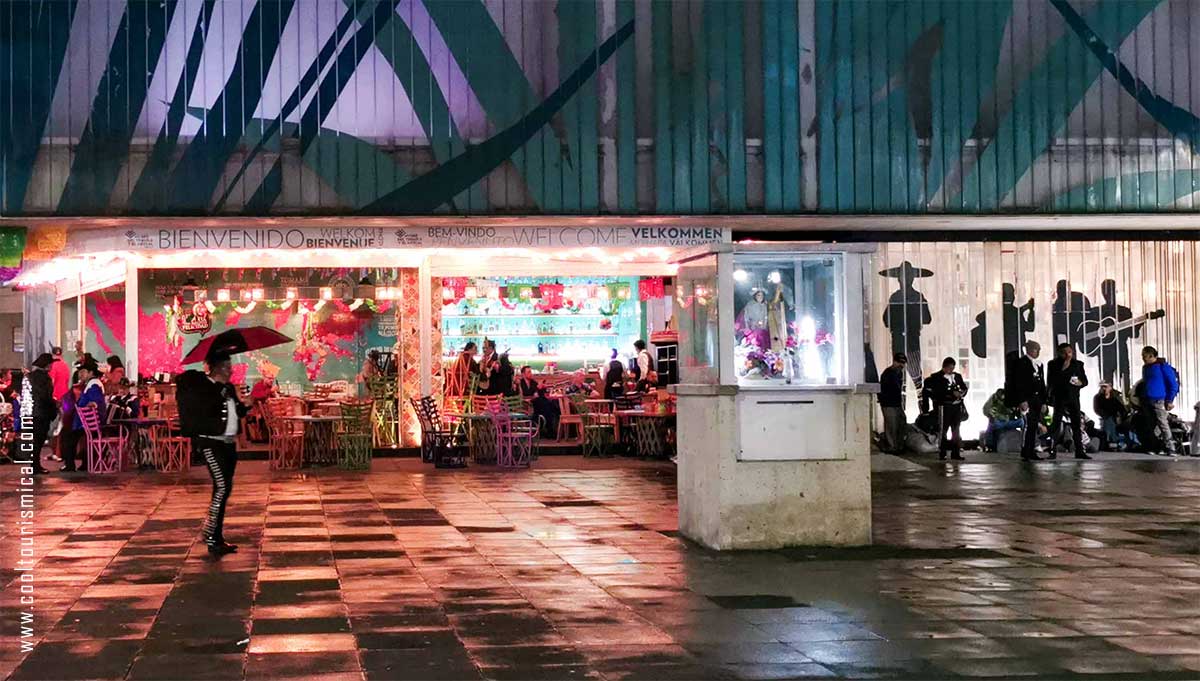
Tequila & Mezcal Museum in Plaza Garibaldi, Copyright © Cooltourismical.com
It’s a cozy, little museum on the eastern side of Plaza Garibaldi, right next to the main access. It’s hard not to notice it colourful and glossy as it is.
Despite its size, it’s quite fascinating. It hosts permanent exhibitions on the history and the process of distillation of the two popular Mexican liquors made from the native agave plant: tequila and mezcal. If you’re into the topic, you’ll find plenty of details about Denomination of Origin regulations and distinct agave-growing regions.
On display, they have antique bottles, historic distillation equipment, old barrels, and even Mexican cultural artefacts such as musical instruments. The centerpiece is a wall of 300 tequila and mezcal bottles. All of them are exhibits that speak in detail on the origins of agave cultivation, the development of tequila and mezcal production, and deep ties to Mexico’s cultural identity, plus insights on mariachi music and Plaza Garibaldi itself.
A key highlight and one of the best things to enjoy in Garibaldi is the museum rooftop bar, where you can sample drinks while overlooking the lively plaza below filled with mariachi music well into the night.
The museum typically charges a modest entrance fee (around 60–80 MXN, though this can vary) and is usually open daily from 11 in the morning until 10 in the evening or later. The bar is open until 2:30 am. For those wanting to take a piece of the experience home, there’s also a gift shop stocked with artisanal bottles and related souvenirs.
📌 Get your tickets: Admission tickets >>
📌 Dining at Tenampa
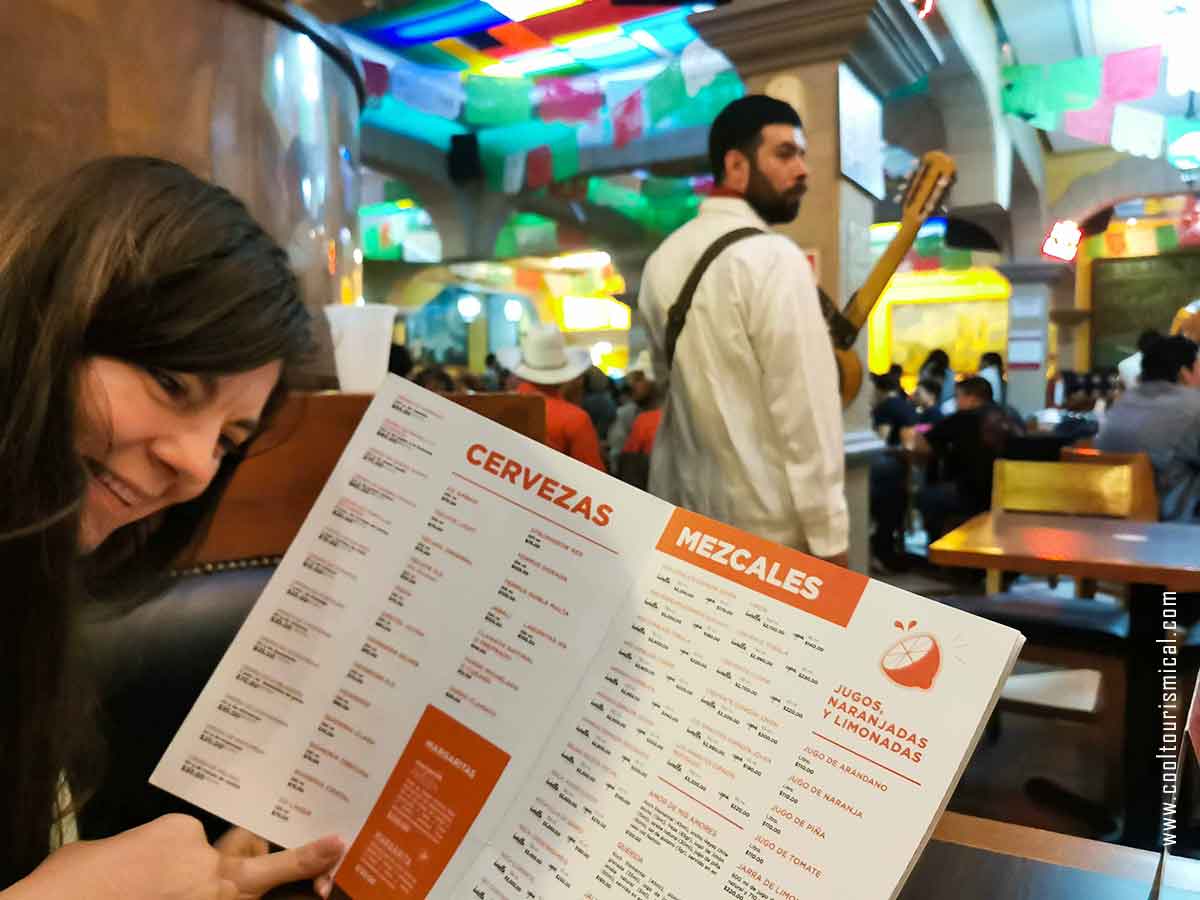
Dinner at Tenampa in Plaza Garibaldi, Copyright © Cooltourismical.com
After walking around for a while and listening to the mariachi in the square, I ended up at Tenampa. Like everyone does. The square is surrounded from all sides by Mexican restaurants and bars. But the most touristy and famous of all is Salón Tenampa. It’s been open for ages.
Tenampa seems full from outside and it’s just around 8 p.m. Most probably because of the weather outside. Even so, a waiter at the entrance invites more and more people in with a generous smile and hurried gestures. As I was suspecting, everything is packed inside, but he still finds for us a private booth somewhere in the back.
Salón Tenampa looks a timeless cantina taken straight out of a classic Mexican film.
On the walls, the 100-year long heritage of this place, and beyond, is depicted: large, colorful murals with scenes of rural Jalisco—where mariachi first flourished—alongside historic photographs and memorabilia that line the panels. All these are celebrating generations of musicians who’ve kept the mariachi tradition alive: Mariachi Vargas de Tecalitlán, Pedro Infante, Javier Solis and the golden list goes on.
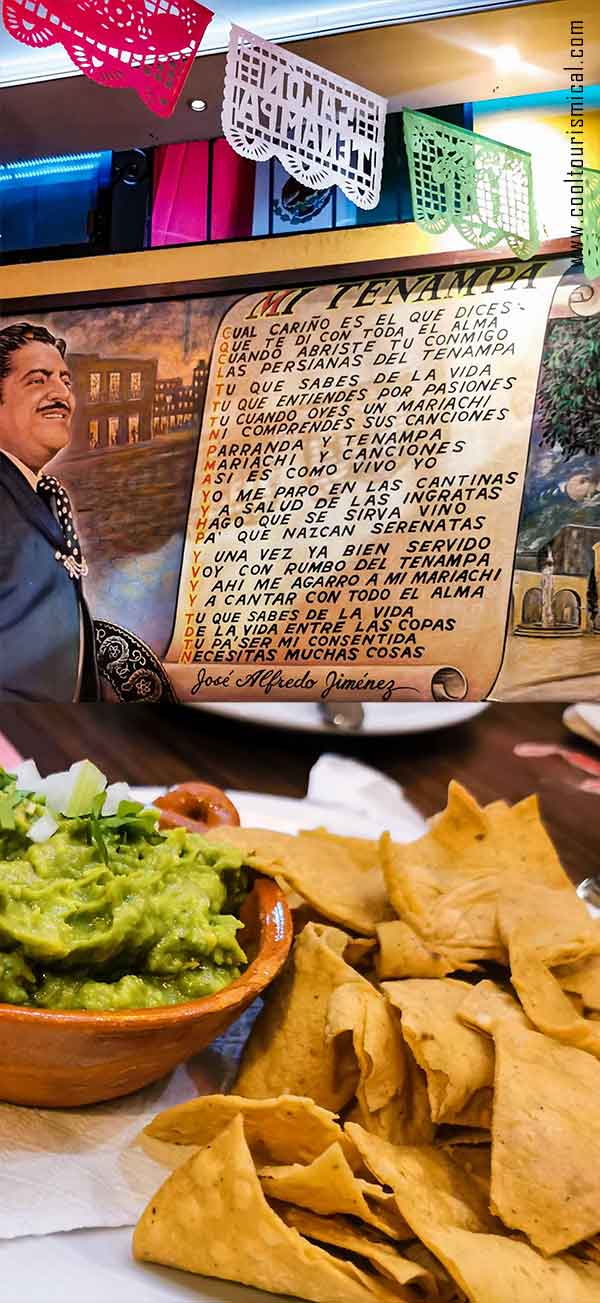
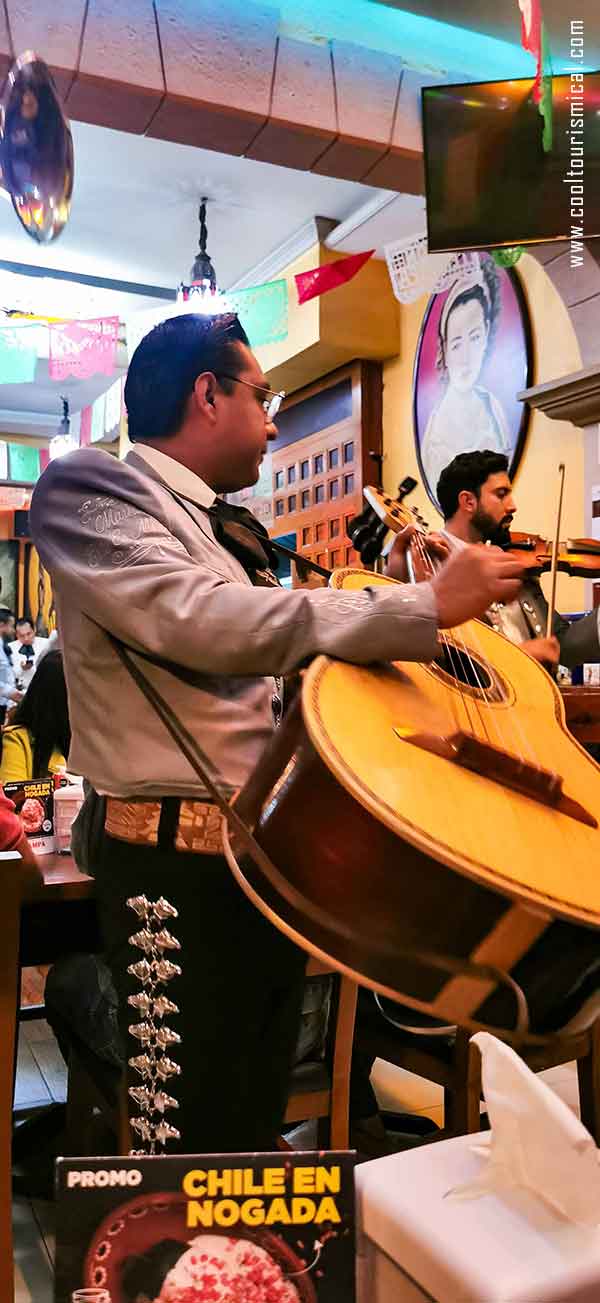
Tenampa: Mexican Food & Mariachi Music, Copyright © Cooltourismical.com
The giant hall wooden tables are already full with people partying. Four or five groups of mariachi are already singing their hearts out while slowly moving between the tables. It’s kind of a happy chaos of voices, laughter and music. Some guests sing along enthusiastically, raising their glasses, while others dance to the music.
You can hear endless tequila shots and beer glasses being poured at the bar, while sizzling plates are making their way towards the tables. It all blends with the rhythmic tap of boots on the tiled floor. It is a communal vibe, and that makes it easy to settle in for a true Mexican night out.
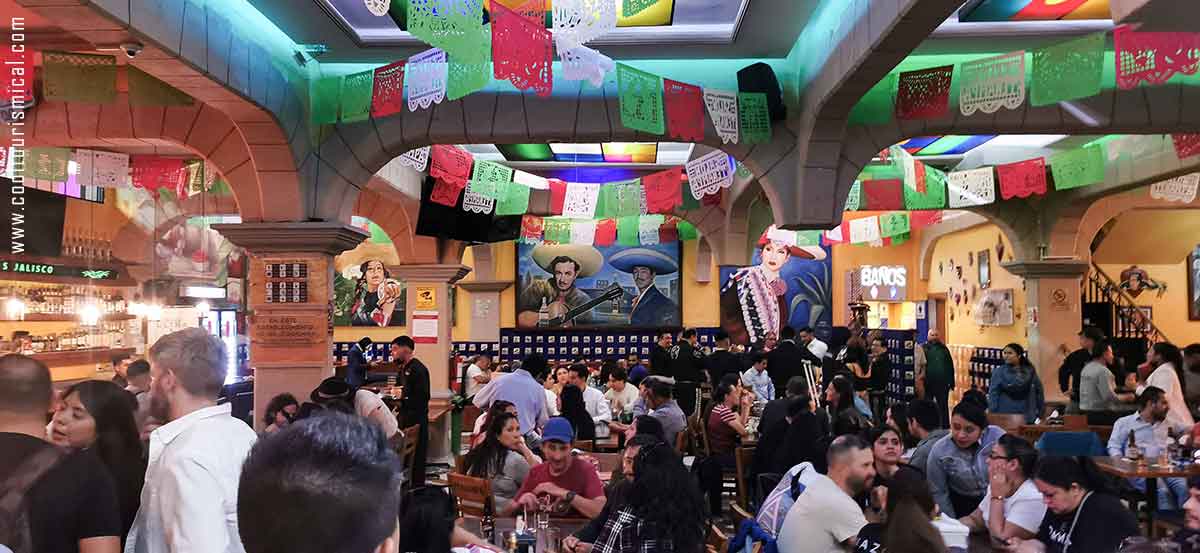
This is actually the place that gave Mexico its rhythms. Salón Tenampa is the musical foundation of the square.
Its owner, originally from Jalisco—widely considered the birthplace of mariachi—brought musicians to perform, introducing the lively sound to the capital. He wanted to make his fellow travelers feel like home. Then the Mexican cinema made Mariachi music even more popular and movie stars from the legendary ‘Charro’ era began playing at the cantina.
Salón Tenampa turned Plaza Garibaldi into the go-to spot for mariachi serenades.
Nearly a century later, the restaurant remains open, having hosted some important political figures and personalities over the decades.
📌 Salón Tenampa generally opens its doors early in the evening—around 6 or 7 PM—and stays open until about 2 AM or later, especially during the weekends.
📌 Visiting the Legends at Paseo de las luminarias
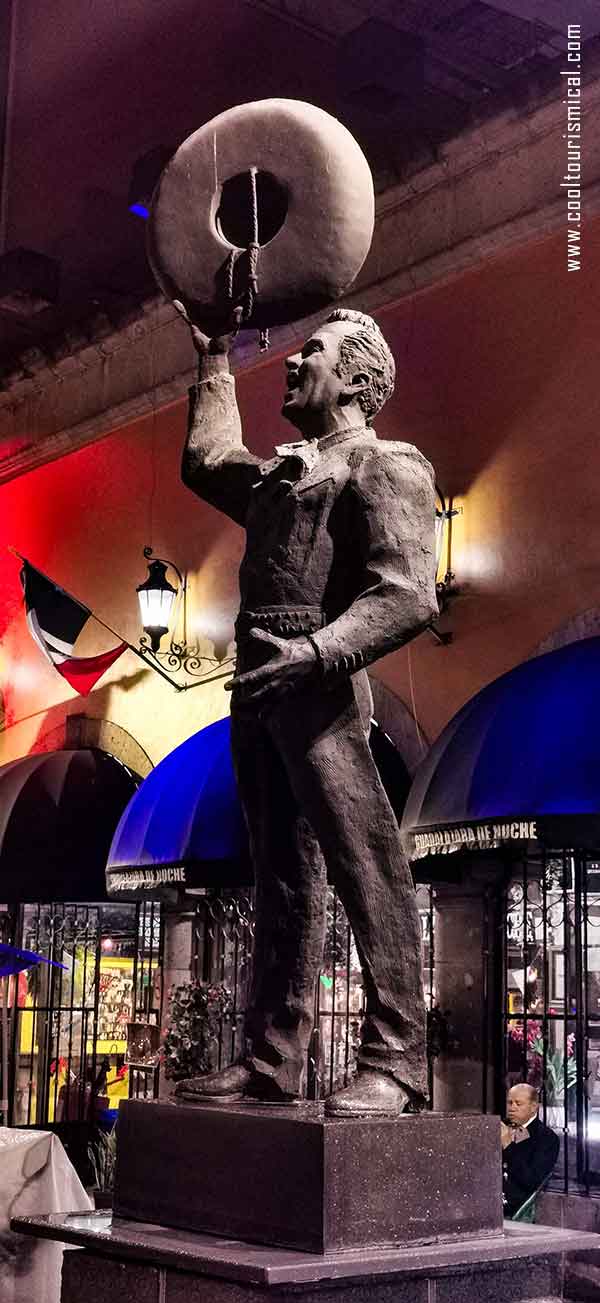
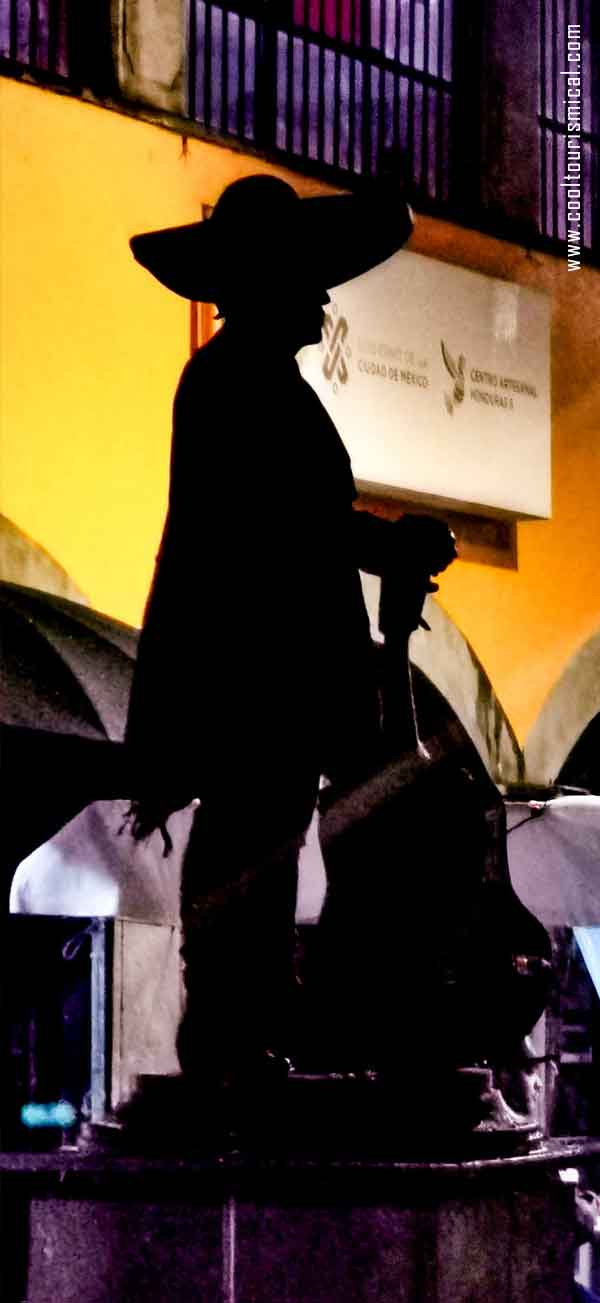
Famous Mariachi Statues in Plaza Garibaldi, Copyright © Cooltourismical.com
On the eastern edge of Plaza Garibaldi, the street República de las Honduras transforms itself into the magical Paseo de las Luminarias. This pedestrian walkway, that feels more like a corridor, has low, colorful houses that line the path, while impossibly tall Mexican fan palms rise like giant candles above it all.
At their feet, there is an impressive collection of metal statues that pays homage to Mexico’s biggest legends, mariachi artists and Mexican cinema cultural icons: Juan Gabriel, Lola Beltrán, Pedro Infante, Chavela Vargas, José Alfredo Jiménez, José Ángel Espinoza “Ferrusquilla,” Javier Solís, and others.
These monuments, perhaps 35 or even 40 years old, once stood in the Plaza Garibaldi itself, but were later on they were repositioned here and raised onto pedestals, gaining their own stage. A real tribute to those guitars gripped with timeless precision, long Mexican shawls draped across shoulders, and wide sombreros standing guard against the sun and rain, forever preserving mariachi legacy.
Definitely worth the short detour!
📌 Watching a Folklore Show at Guadalajara de Noche
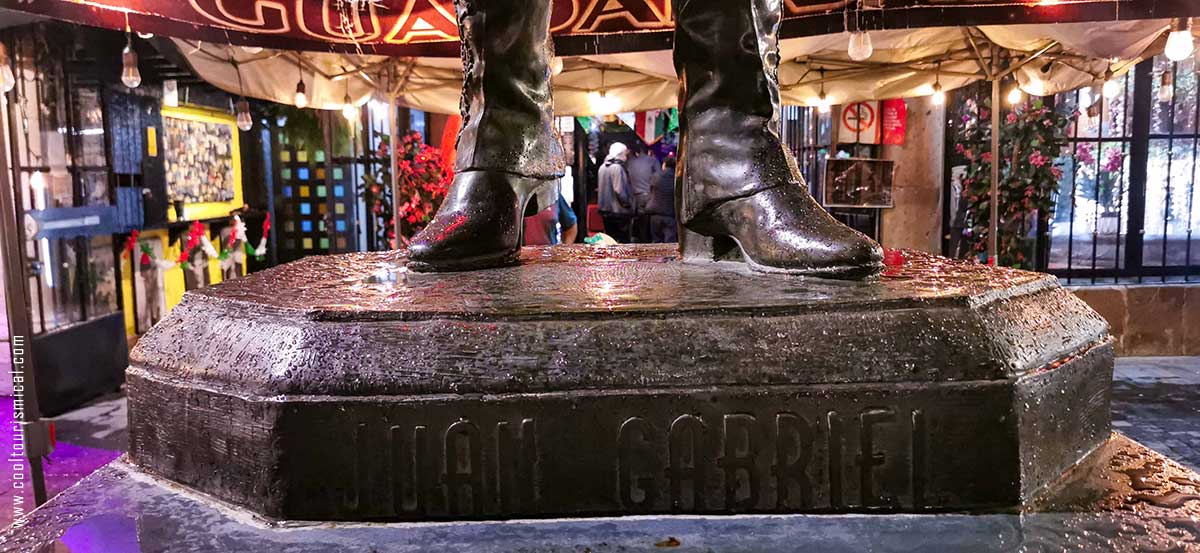
Guadalajara de Noche, Plaza Garibaldi, Copyright © Cooltourismical.com
2-minutes walking from Tenampa, on Republica de Honduras and on the Paseo de las luminarias, just behind the statue of Juan Gabriel, there is Guadalajara de Noche. Another venue in Plaza Garibaldi, also inspired by the spirit of Jalisco, which is said to have been opened in the late 1930’s. But the atmosphere is quite different from Tenampa.
It’s a long-standing restaurant-cabaret hybrid with evening shows on stage, one of the rarest things to experience in Garibaldi. Try to get there around 7 or 9 pm. They have live mariachi bands, traditional Mexican dance performances, and a menu inspired by the cuisine of Jalisco: birria, tortas ahogadas, fajitas, tequila and mezcal cocktails.
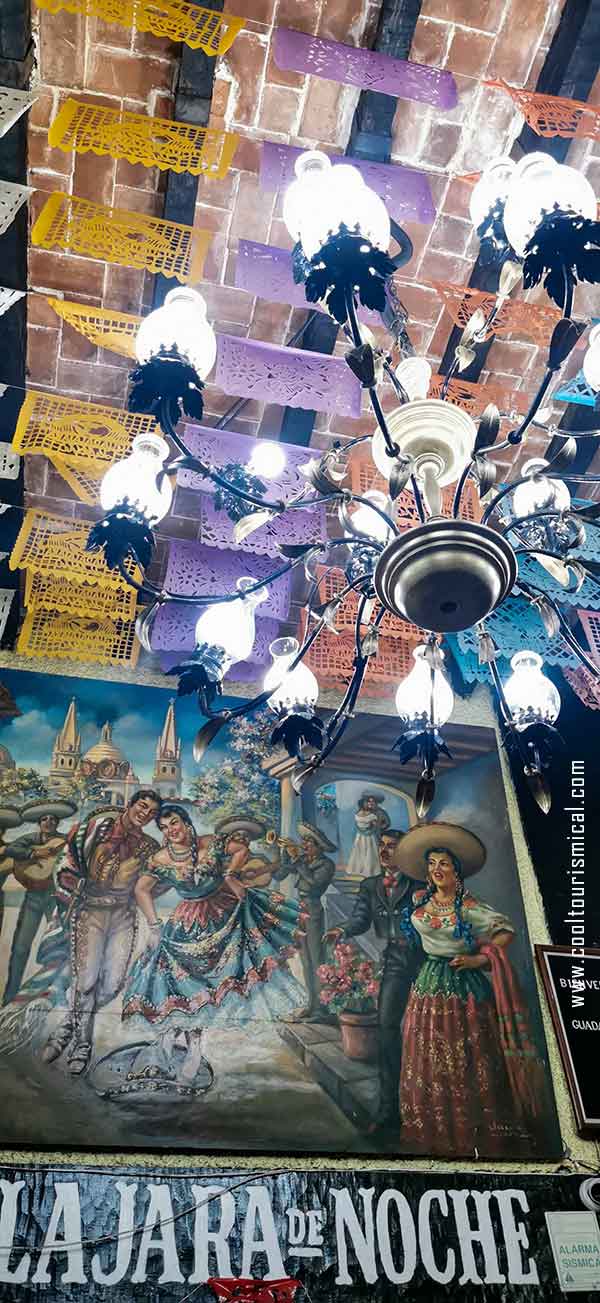
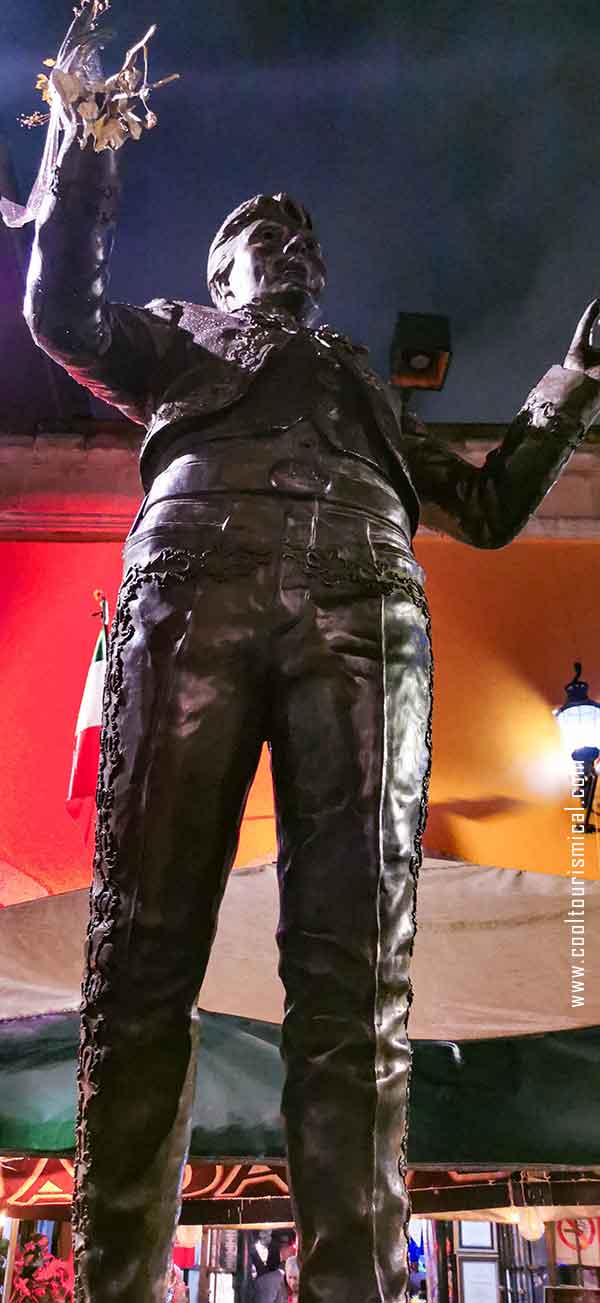
Guadalajara de Noche & Statue of Juan Gabriel in the Plaza, Copyright © Cooltourismical.com
The food is average, so don’t get your hopes too high. But the shows is excellent: colorful costumes, cumbias and ballads, mariachi classics and, spiritual dances connected to ancient rituals, witches, sacred animals and Aztec gods.
There is no need to order food. You will only have to pay for the show. And you can order some drinks. Walkins are ok, as there is a lot of space on two floors, No reservation is needed.
I do recommend this place because they are preserving the ancient dances from all over Mexico, authentic ranchera and mariachi traditions . It is an unmissable staple for Mexico City’s nightlife and a key attraction in Plaza Garibaldi.
📌 Get your tickets: Get a tour including Guadalajara de Noche show >>
📌 Shopping for Souvenirs & Snapping Pictures at Mercado San Camilito
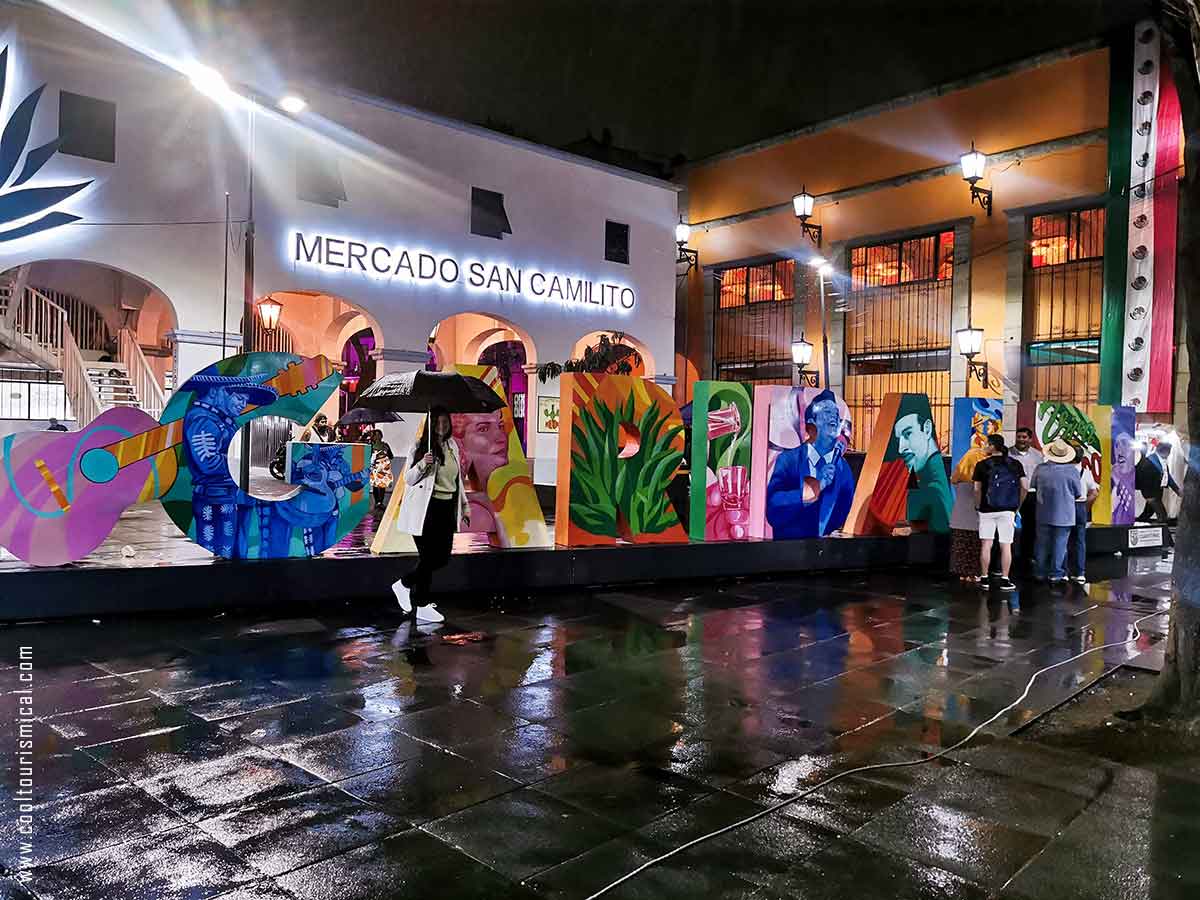
Mercado San Camilito in Plaza Garibaldi, Mexico City, Copyright © Cooltourismical.com
Mercado San Camilito is the all-night fiesta gastronomic hub of Plaza Garibaldi, boldly going head-to-head with the famed Tenampa. Dozens of eateries are gathered in this place, serving more affordable bites since the ’50s. It’s located on the northern side of Garibaldi, right where Eje Central Lázaro Cárdenas meets República de Honduras.
But the surroundings have made San Camilito to mean more than food.
Outside the market hall, colorful kiosks are completely crowded with lots of quirky Mexican souvenirs to shop while in Plaza Garibaldi. Creepy skulls, shot glasses, cute Katrina dolls, mariachi hats, musical instruments, ponchos, and even simple umbrellas (well needed on rainy nights) are carelessly, yet somehow charmingly hanging or stacked on top of each other, each lovely piece desperately trying to make itself seen.
And don’t miss the Instagram hotspot right in front of the market! Nine monumental letters spell out “Garibaldi,” surrounded by iconic details: a striking maguey, lively mariachi groups, dancing performers, and the proud phrase “Viva México.”, portraits of Mexican music and cinema legends like Pedro Infante and Jorge Negrete—although there are many other things to do in Plaza Gribaldi, I found this to be the perfect photo op.
📌 Daring to Step onto Callejón de la Amargura
Callejón de la Amargura, or “Alley of Bitterness,” is said to have been a gathering spot for locals, full of stories of love, heartbreak, and sometimes even mischief, in the old, old days of Mexico City. Still, drowned in tequila and mariachi music, the past of the alley remains wrapped mostly in rumours.
A hub of the community, with large tenement houses (vecindades) on its sides and opening into the Garden of Santa Cecilia, now all gone, the vibe, old theatres and restaurants. Despite its decline, the alley remains an important piece of Garibaldi’s cultural essence, even serving as a filming location for “Me caí de la nube“, a classic Mexican film starring Cornelio Reyna.
Memories of Callejón de la Amargura, next to Plaza Garibaldi, live on also through nostalgic reflections. Journalist Marco Levario Turcott recalls the 1970s, when it was filled with camaraderie and lively pulquerías like La Hermosa Hortensia, where he sipped peanut-flavored pulque and shared stories with old friends. Some locals associate the alley’s name with past crimes, but others, like photographer José Enrique (for La Jornada), see it as a peaceful place with untapped potential.
Today, Callejón de la Amargura is undergoing a slow revival and it is home to the Escuela de Mariachi Ollin Yoliztli Garibaldi, a school that trains new generations of mariachi musicians. From time to time, they offer free recitals.
 Attractions close by Plaza Garibaldi
Attractions close by Plaza Garibaldi
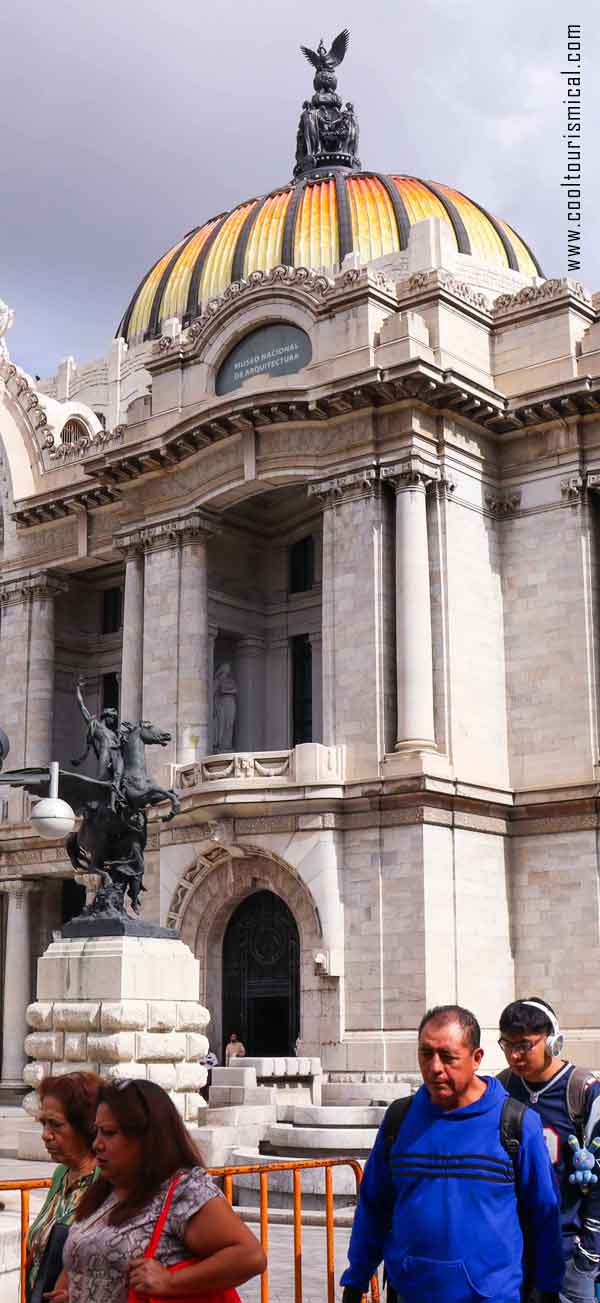

Nearby Attractions: Palacio de Bellas Artes & Alameda Central, Copyright © Cooltourismical.com
Actually, Plaza Garibaldi is a quick 10-minute walk to the south into the heart of the city’s historic museum area, along Eje Central Lázaro Cárdenas. This street opens up to a cultural heaven, at Palacio de Bellas Artes, the largest arts center in the country, and its legendary La Ópera Bar, where fancy cocktails are served right beneath the bullet holes left by Pancho Villa. Behind the palace, there is the lush park of Alameda Central surrounded by countless museums and galleries.
Head east from Garibaldi and you’ll find Arena Coliseo. This is home to some quite thrilling Lucha Libre shows, obviously only if you’re a fan. I noticed that many organized tours have been awkwardly bundling a visit to Garibaldi with a lucha libre experience – most probably thanks to the short distance between them, because the romantic charm of mariachi and high-flying acrobatic masked wrestlers don’t seem like a match. Then again, that’s just me!
 How to get there
How to get there
If you’re staying in the Centro Histórico area, Plaza Garibaldi is located on on Lázaro Cárdenas. within walking distance from almost anything there, – 10–15 minutes from Alameda Central, Palacio de Bellas Artes, or Zócalo.
Still, if your accommodation in CDMX is further away, you can easily use the metro. The nearest metro station is Garibaldi – Lagunilla (Line 8, Garibaldi exit), just a few steps away from the Plaza. There are also a lot of bus stations around the Plaza. The Metrobús Línea 7 runs along Reforma, stopping at Garibaldi, and Line 4 (the route to the airport) drops you off at Teatro Blanquita, not far from the square.
After dark, though, even if the last metro leaves around midnight, I’d recommend using ridesharing apps like Uber or Didi instead of walking or taking public transport—the area can feel a bit sketchy at night. Personally, I used Uber, and it was safe and easy!
 The Style Guide: What to Wear to Plaza Garibaldi
The Style Guide: What to Wear to Plaza Garibaldi
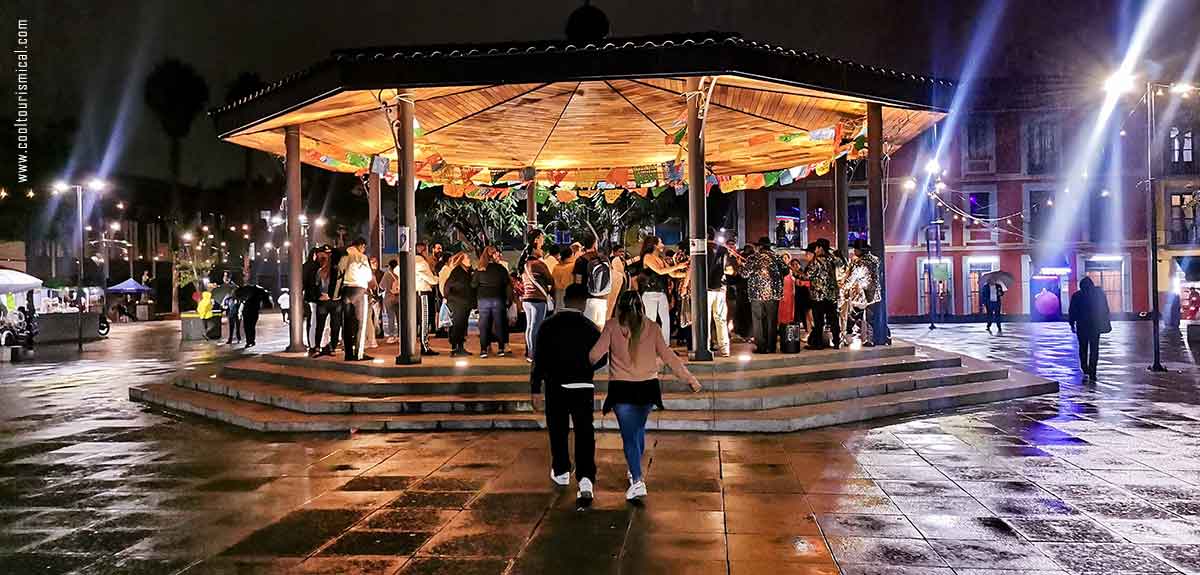
People in the Plaza, Copyright © Cooltourismical.com
For a night out in Plaza Garibaldi, your outfit should match the party vibe: comfortable and ready for fun! You can opt for casual clothing like jeans, flowy dresses, everyday pants, cute tops or fun shirts. Bright, bold colors or patterns blend right into the party atmosphere. Add a sombrero if you dare.
Plaza Garibaldi isn’t fancy, so there’s no need to dress up too much. Plus, the mariachi bands will outshine everyone no matter what you wear! Still, comfort should come first. You’ll likely be walking around, dancing, or just standing to watch the mariachi bands. Go for comfy shoes, sneakers, ankle boots, or anything you can stand in for hours.
Keep accessories practical with a crossbody bag for your essentials and minimal jewelry to stay secure. If rain’s a possibility, pack a small umbrella.
 Do I need a Guide to Visit Plaza Garibaldi?
Do I need a Guide to Visit Plaza Garibaldi?
Not really. You don’t actually need a guide. Plaza Garibaldi is one of those places in Mexico City where you can just show up. For the most part, just wandering around, grabbing a drink, and letting the mariachi music guide your night is enough.
You can hire mariachi, eat at Tenampa and visit the museum, all on your own.
But if you want to feel safer and get a deeper understanding of mariachi culture or the neighborhood’s past, a guide is never a bad idea. There are organized tours that include tequila tastings, visits to the Museo del Tequila y el Mezcal, and various shows (right on the plaza). It’s up to you and how brave you feel.
Some of the best rated tours for Plaza Garibaldi, below.
 Is It Safe to Visit Plaza Garibaldi?
Is It Safe to Visit Plaza Garibaldi?
To me, Plaza Garibaldi itself looked safe. Outside of the plaza, not so much. I came around 8:00 p.m. and left around 10:30 p.m.
Police is always patrolling in and around the square. However, caution is never a bad idea, especially if you’re planning to visit in the evening. The Plaza can still attract pickpockets or scammers, particularly around the crowded areas where mariachi bands perform.
When leaving, I do recommend avoiding the metro at late hours, as the streets surrounding Plaza Garibaldi can feel less secure. I’ve seen a bunch of homeless outside the plaza which made me feel a bit uncomfortable. To be honest, when I left, I thought about walking toward the old center, but the sight out there changed my mind pretty quickly. I turned around, went back to the plaza, and called an Uber instead. Definitely felt like the smarter move.
Consider also the fact that Garibaldi Plaza is in the proximity of Tepito neighbourhood — which has a pretty rough reputation — and the vibe can get even sketchier. To make sure you’re safe, better use a ride sharing app.
 Why Plaza Garibaldi Will Steal Your Heart
Why Plaza Garibaldi Will Steal Your Heart
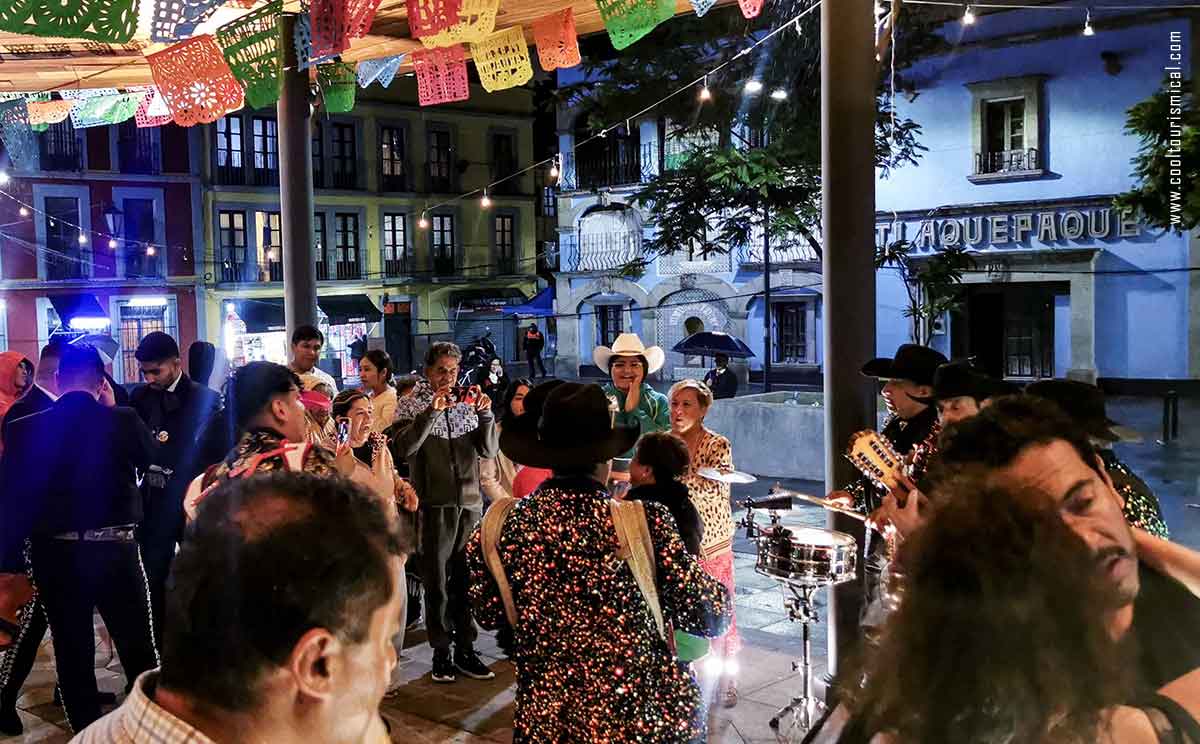
People dancing on Mariachi music in Plaza Garibaldi, Copyright © Cooltourismical.com
Simple: because Plaza Garibaldi it’s unapologetically raw, wild, and alive. It’s Mexican history, music, with a whole lot of soul! You can forget the polished, postcard-perfect vibes—this place is the real deal, oozing culture and chaos in equal measure.
It’s not spotless or luxurious, but that’s what makes it authentic. So, visit with an open mind.
You’ll yearn for the juicy tacos al pastor, gooey quesadillas, or smoky elotes, all chased down with tequila, mezcal, or the ancient, frothy weirdness of pulque. And you’ll want to stick around for the Aztec shows—dancers will be pounding the pavement like they’re channelling the gods.
Plus, there is nothing more fun than shopping for trippy treasures like Katrina dolls and other bizarre, pure Mexican finds. And after you’ve lock eyes with legendary statues in the Paseo de las Luminarias—all guitar-strumming giants frozen in time, you can let today’s mariachi music ignite that something primal in you. Be happy, scream the lyrics, and let your feet take over. Dance, dance, dance till the sun peeks over the buildings in the plaza.
Plaza Garibaldi is an experience, one that grabs hold of you and doesn’t let go.
📌 Other places that are not Plaza Garibaldi, but you can still see the mariachi: Where to listen to mariachi in Mexico City >>
So, what are your thoughts? Are you planning to visit Plaza Garibaldi to see the mariachi? And did you know this is one of the best Monday activities in Mexico City? Or have you been already? If so, how was it? Any favourite spots? Leave your comments and questions below — I would love to hear about your experience.

